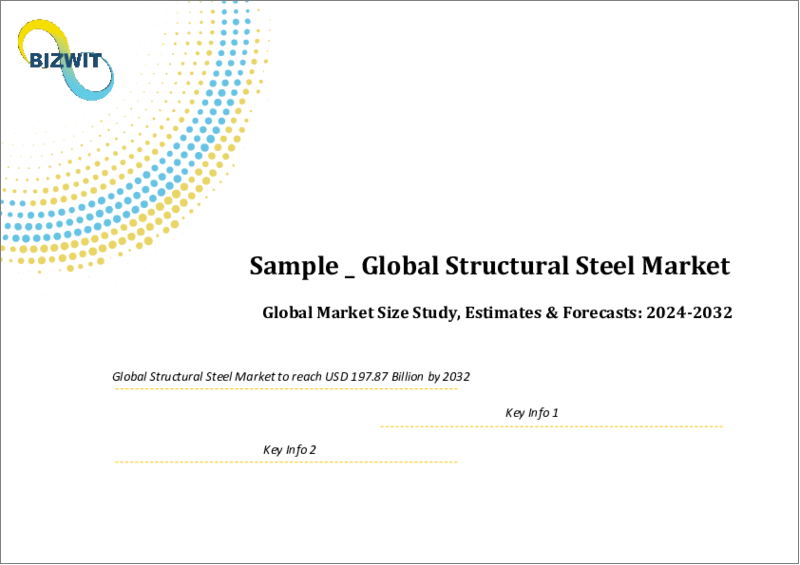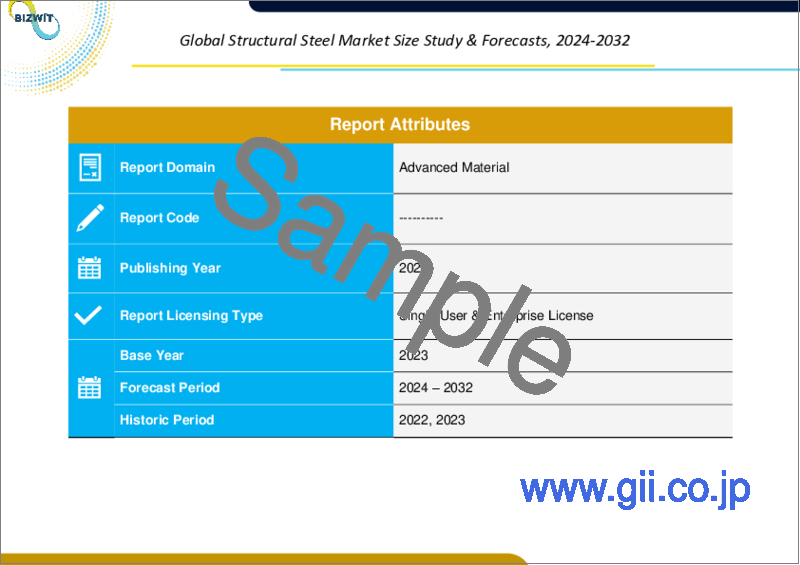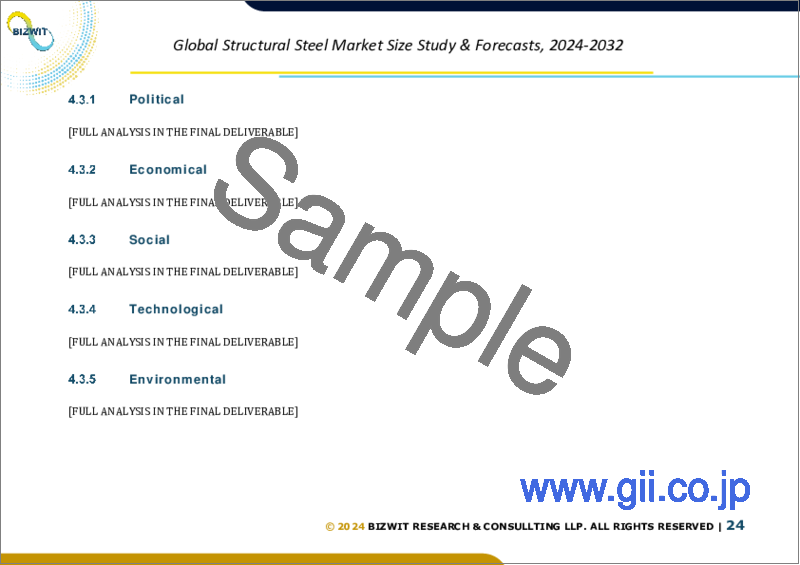|
|
市場調査レポート
商品コード
1517322
構造用鋼の世界市場規模調査:製品別、用途別、地域別予測、2024-2032年Global Structural Steel Market Size study, by Product (Angles, Channels, Rounds, Squares, Beams), by Application (Residential, Non-residential, Institutional, Commercial, Offices, Others) and Regional Forecasts 2024-2032 |
||||||
カスタマイズ可能
|
|||||||
| 構造用鋼の世界市場規模調査:製品別、用途別、地域別予測、2024-2032年 |
|
出版日: 2024年07月15日
発行: Bizwit Research & Consulting LLP
ページ情報: 英文 200 Pages
納期: 2~3営業日
|
全表示
- 概要
- 目次
世界の構造用鋼市場は2023年に約1,171億2,000万米ドルと評価され、予測期間2024-2032年には6.01%以上の健全な成長率で成長すると予測されています。
構造用鋼はそのリサイクル性が評価され、グリーンビルディングの増加に合致しています。世界グリーンビルディング協議会(World Green Building Council)によると、米国ではグリーンビルディングによって水使用量が11%削減され、エネルギー使用量は25%削減されます。米国のグリーンビルディング分野で大きなシェアを占めるカリフォルニア州は、2030年までにゼロ・ネット・エネルギーを達成する見込みで、構造用鋼材の需要をさらに押し上げます。市場は、新興国市場と先進国市場の両方におけるインフラ整備が牽引しており、住宅ニーズの高まりが大きく寄与しています。国連は、2100年までに世界人口が112億人に達すると予測しており、これが住宅需要を押し上げ、ひいては構造用鋼の消費を促進すると予想されます。
米国の建設業界は2023年に復活を遂げ、COVID-19パンデミックの影響から回復し、全体として6.1%の成長を遂げました。この成長を牽引したのは製造業で、次いで商業、住宅と続く。高層ビルの建設も市場を牽引する重要な要因です。構造用鋼は重量に対する強度が高く、高層ビルを支えるのに理想的だからです。現在、アジアを中心に数多くの高層ビルが建設中であり、これが市場成長の原動力になると予想されます。しかし、鉄鋼や鉄、石炭、スクラップなどの原材料価格が変動するため、市場は不安定さという課題に直面しています。生産コストや貯蔵能力も価格に直接影響します。このような課題にもかかわらず、多数のプレーヤーと適度な技術革新レベルを特徴とする市場の断片化された性質は、建築・建設セグメントにおける需要の増大に対応するための新製品の継続的開拓と生産プロセスの最適化を可能にしています。
3D Secure Payment Authenticationの世界市場調査において考慮した主要地域には、北米、欧州、アジア太平洋、ラテンアメリカ、中東・アフリカが含まれます。北米は2023年に大きな市場シェアを占めました。北米の構造用鋼材市場は、住宅、商業、工業、インフラ部門の建設活動によって大きく成長しています。北米の構造用鋼市場は、製造業者、加工業者、建設業界の利害関係者にとって、多様な用途における耐久性があり、効率的で持続可能な建築材料の需要を活用する機会を提供しています。さらに、アジア太平洋地域は予測期間2024年から2032年にかけて最も高い成長率を記録すると予測されています。
目次
第1章 構造用鋼の世界市場エグゼクティブサマリー
- 構造用鋼の世界市場規模・予測(2024-2030年)
- 地域別概要
- セグメント別概要
- 製品別
- 用途別
- 主要動向
- 景気後退の影響
- アナリストの結論・提言
第2章 世界の構造用鋼市場の定義と調査前提条件
- 調査目的
- 市場の定義
- 調査前提条件
- 包含と除外
- 制限事項
- 供給サイドの分析
- 入手可能性
- インフラ
- 規制環境
- 市場競争
- 経済性(消費者の視点)
- 需要サイド分析
- 規制の枠組み
- 技術の進歩
- 環境への配慮
- 消費者の意識と受容
- 調査手法
- 調査対象年
- 通貨換算レート
第3章 世界の構造用鋼市場力学
- 市場促進要因
- インフラ開発
- 高まる住宅ニーズ
- グリーンビルディングの台頭
- 市場の課題
- 価格変動
- サプライチェーンの混乱
- 市場機会
- 生産技術の進歩
- 高層ビル建設の成長
第4章 世界の構造用鋼市場、産業分析
- ポーターのファイブフォースモデル
- 供給企業の交渉力
- 買い手の交渉力
- 新規参入業者の脅威
- 代替品の脅威
- 競争企業間の敵対関係
- ポーターのファイブフォースモデルへの未来的アプローチ
- ポーターのファイブフォースの影響分析
- PESTEL分析
- 政治
- 経済
- 社会
- 技術
- 環境
- 法律
- 主な投資機会
- 主要成功戦略
- 破壊的動向
- 業界専門家の視点
- アナリストの結論・提言
第5章 構造用鋼の世界市場規模と予測:製品別、2022年~2032年
- セグメントダッシュボード
- 構造用鋼の世界市場:収益動向分析、2022年・2032年
- 角度
- チャンネル
- ラウンド
- 角材
- 梁
第6章 構造用鋼の世界市場規模と予測:用途別、2022年~2032年
- セグメントダッシュボード
- 構造用鋼の世界市場:収益動向分析、2022年・2032年
- 住宅
- 非住宅
- 施設
- 商業
- オフィス
- その他
第7章 構造用鋼の世界市場規模と予測:地域別、2022年~2032年
- 北米の構造用鋼市場
- 米国の構造用鋼市場
- カナダの構造用鋼市場
- 欧州構造用鋼市場
- ドイツの構造用鋼市場
- 英国の構造用鋼市場
- フランスの構造用鋼市場
- イタリアの構造用鋼市場
- スペインの構造用鋼市場
- その他欧州の構造用鋼市場
- アジア太平洋の構造用鋼市場
- 中国の構造用鋼市場
- インドの構造用鋼市場
- 日本の構造用鋼市場
- 韓国の構造用鋼市場
- オーストラリアの構造用鋼市場
- その他アジア太平洋地域の構造用鋼市場
- ラテンアメリカの構造用鋼市場
- ブラジルの構造用鋼市場
- メキシコの構造用鋼市場
- その他ラテンアメリカの構造用鋼市場
- 中東・アフリカの構造用鋼市場
- サウジアラビアの構造用鋼市場
- アラブ首長国連邦の構造用鋼市場
- 南アフリカの構造用鋼市場
- その他中東とアフリカの構造用鋼市場
第8章 競合情報
- 主要企業のSWOT分析
- 主要市場戦略
- 企業プロファイル
- Arcelor Mittal S.A.
- 主要情報
- 概要
- 財務(データの入手可能性による)
- 製品概要
- 市場戦略
- Baogang Group
- Evraz plc
- Gerdau S.A
- Nippon Steel Corporation
- JSW Steel Limited
- Tata Steel Limited
- SAIL
- Wuhan Iron & Steel(Group)Corp
- Hebei Steel Group
- Baosteel Group Corporation
- Bohai Steel Group Co. Ltd.
- Anshan Iron & Steel Group Co., Ltd.
- HBIS Group
- Anyang Iron & Steel Group Co., Ltd.
- Arcelor Mittal S.A.
第9章 調査プロセス
- 調査プロセス
- データマイニング
- 分析
- 市場推定
- 検証
- 出版
- 調査属性
Global Structural Steel Market was valued at approximately USD 117.12 billion in 2023 and is anticipated to grow with a healthy growth rate of more than 6.01% over the forecast period 2024-2032. Structural steel is recognized for its recyclability, which aligns with the rising number of green buildings. Green buildings, as per the World Green Building Council, reduce water usage by 11% and energy usage by 25% in the U.S. The growing emphasis on green construction is anticipated to propel the market in the coming years. California, holding a significant share in the green building segment in the U.S., is expected to achieve zero net energy by 2030, further boosting the demand for structural steel. The market is driven by infrastructural developments across both developing and developed nations, with growing housing needs being a significant contributor. The United Nations projects the global population to reach 11.2 billion by 2100, which is expected to bolster housing demand and, in turn, drive the consumption of structural steel.
The construction industry in the U.S. saw a resurgence in 2023, recovering from the impacts of the COVID-19 pandemic with an overall growth of 6.1%. This growth was notably driven by the manufacturing sector, followed by commercial and residential sectors. High-rise building construction is also a key factor driving the market, given structural steel's high strength-to-weight ratio, making it ideal for supporting tall buildings. Currently, there are numerous high-rise buildings under construction, primarily in Asia, which is expected to drive market growth. However, the market faces challenges due to fluctuating prices of steel and raw materials like iron, coal, and scrap, leading to volatility. Production costs and storage capacity also impact prices directly. Despite these challenges, the fragmented nature of the market, characterized by numerous players and moderate innovation levels, allows for the continuous development of new products and optimization of production processes to meet the growing demand in the building and construction segment.
The key regions considered for the Global 3D Secure Payment Authentication Market study include North America, Europe, Asia Pacific, Latin America, and the Middle East and Africa. North America accounted for a significant market share in 2023. The North America structural steel market is significant, driven by construction activities in residential, commercial, industrial, and infrastructure sectors. Factors contributing to market growth include urbanization, industrialization, infrastructure development projects, and renovations in existing structures. the structural steel market in North America presents opportunities for manufacturers, fabricators, and stakeholders in the construction industry to capitalize on the demand for durable, efficient, and sustainable building materials across diverse applications. Furthermore, the Asia-Pacific region is projected to experience the highest growth rate during the forecast period 2024-2032.
Major market player included in this report are:
- Arcelor Mittal S.A.
- Baogang Group
- Evraz plc
- Gerdau S.A.
- Nippon Steel Corporation
- JSW Steel Limited
- Tata Steel Limited
- SAIL
- Wuhan Iron & Steel (Group) Corp
- Hebei Steel Group
- Baosteel Group Corporation
- Bohai Steel Group Co. Ltd.
- Anshan Iron & Steel Group Co., Ltd.
- HBIS Group
- Anyang Iron & Steel Group Co., Ltd.
The detailed segments and sub-segment of the market are explained below:
By Product:
- Angles
- Channels
- Rounds
- Squares
- Beams
By Application:
- Residential
- Non-residential
- Institutional
- Commercial
- Offices
- Others
By Region:
- North America
- U.S.
- Canada
- Europe
- Germany
- UK
- France
- Italy
- Spain
- Rest of Europe
- Asia Pacific
- China
- India
- Japan
- South Korea
- Australia
- Rest of Asia Pacific
- Latin America
- Brazil
- Mexico
- Rest of Latin America
- Middle East & Africa
- Saudi Arabia
- South Africa
- Rest of Middle East & Africa
Years considered for the study are as follows:
- Historical year - 2022
- Base year - 2023
- Forecast period - 2024 to 2032
Key Takeaways:
- Market Estimates & Forecast for 10 years from 2022 to 2032.
- Annualized revenues and regional level analysis for each market segment.
- Detailed analysis of geographical landscape with Country level analysis of major regions.
- Competitive landscape with information on major players in the market.
- Analysis of key business strategies and recommendations on future market approach.
- Analysis of competitive structure of the market.
- Demand side and supply side analysis of the market.
Table of Contents
Chapter 1. Global Structural Steel Market Executive Summary
- 1.1. Global Structural Steel Market Size & Forecast (2024-2030)
- 1.2. Regional Summary
- 1.3. Segmental Summary
- 1.3.1. By Product
- 1.3.2. By Application
- 1.4. Key Trends
- 1.5. Recession Impact
- 1.6. Analyst Recommendation & Conclusion
Chapter 2. Global Structural Steel Market Definition and Research Assumptions
- 2.1. Research Objective
- 2.2. Market Definition
- 2.3. Research Assumptions
- 2.3.1. Inclusion & Exclusion
- 2.3.2. Limitations
- 2.3.3. Supply Side Analysis
- 2.3.3.1. Availability
- 2.3.3.2. Infrastructure
- 2.3.3.3. Regulatory Environment
- 2.3.3.4. Market Competition
- 2.3.3.5. Economic Viability (Consumer's Perspective)
- 2.3.4. Demand Side Analysis
- 2.3.4.1. Regulatory frameworks
- 2.3.4.2. Technological Advancements
- 2.3.4.3. Environmental Considerations
- 2.3.4.4. Consumer Awareness & Acceptance
- 2.4. Estimation Methodology
- 2.5. Years Considered for the Study
- 2.6. Currency Conversion Rates
Chapter 3. Global Structural Steel Market Dynamics
- 3.1. Market Drivers
- 3.1.1. Infrastructural Developments
- 3.1.2. Growing Housing Needs
- 3.1.3. Rise in Green Buildings
- 3.2. Market Challenges
- 3.2.1. Price Fluctuations
- 3.2.2. Supply Chain Disruptions
- 3.3. Market Opportunities
- 3.3.1. Technological Advancements in Production
- 3.3.2. Growth in High-rise Building Construction
Chapter 4. Global Structural Steel Market Industry Analysis
- 4.1. Porter's 5 Force Model
- 4.1.1. Bargaining Power of Suppliers
- 4.1.2. Bargaining Power of Buyers
- 4.1.3. Threat of New Entrants
- 4.1.4. Threat of Substitutes
- 4.1.5. Competitive Rivalry
- 4.1.6. Futuristic Approach to Porter's 5 Force Model
- 4.1.7. Porter's 5 Force Impact Analysis
- 4.2. PESTEL Analysis
- 4.2.1. Political
- 4.2.2. Economical
- 4.2.3. Social
- 4.2.4. Technological
- 4.2.5. Environmental
- 4.2.6. Legal
- 4.3. Top investment opportunity
- 4.4. Top winning strategies
- 4.5. Disruptive Trends
- 4.6. Industry Expert Perspective
- 4.7. Analyst Recommendation & Conclusion
Chapter 5. Global Structural Steel Market Size & Forecasts by Product 2022-2032
- 5.1. Segment Dashboard
- 5.2. Global Structural Steel Market: Product Revenue Trend Analysis, 2022 & 2032 (USD Billion)
- 5.2.1. Angles
- 5.2.2. Channels
- 5.2.3. Rounds
- 5.2.4. Squares
- 5.2.5. Beams
Chapter 6. Global Structural Steel Market Size & Forecasts by Application 2022-2032
- 6.1. Segment Dashboard
- 6.2. Global Structural Steel Market: Application Revenue Trend Analysis, 2022 & 2032 (USD Billion)
- 6.2.1. Residential
- 6.2.2. Non-residential
- 6.2.2.1. Institutional
- 6.2.2.2. Commercial
- 6.2.2.3. Offices
- 6.2.2.4. Others
Chapter 7. Global Structural Steel Market Size & Forecasts by Region 2022-2032
- 7.1. North America Structural Steel Market
- 7.1.1. U.S. Structural Steel Market
- 7.1.1.1. Product breakdown size & forecasts, 2022-2032
- 7.1.1.2. Application breakdown size & forecasts, 2022-2032
- 7.1.2. Canada Structural Steel Market
- 7.1.2.1. Product breakdown size & forecasts, 2022-2032
- 7.1.2.2. Application breakdown size & forecasts, 2022-2032
- 7.1.1. U.S. Structural Steel Market
- 7.2. Europe Structural Steel Market
- 7.2.1. Germany Structural Steel Market
- 7.2.2. UK Structural Steel Market
- 7.2.3. France Structural Steel Market
- 7.2.4. Italy Structural Steel Market
- 7.2.5. Spain Structural Steel Market
- 7.2.6. Rest of Europe Structural Steel Market
- 7.3. Asia-Pacific Structural Steel Market
- 7.3.1. China Structural Steel Market
- 7.3.2. India Structural Steel Market
- 7.3.3. Japan Structural Steel Market
- 7.3.4. South Korea Structural Steel Market
- 7.3.5. Australia Structural Steel Market
- 7.3.6. Rest of Asia Pacific Structural Steel Market
- 7.4. Latin America Structural Steel Market
- 7.4.1. Brazil Structural Steel Market
- 7.4.2. Mexico Structural Steel Market
- 7.4.3. Rest of Latin America Structural Steel Market
- 7.5. Middle East & Africa Structural Steel Market
- 7.5.1. Saudi Arabia Structural Steel Market
- 7.5.2. UAE Structural Steel Market
- 7.5.3. South Africa Structural Steel Market
- 7.5.4. Rest of Middle East & Africa Structural Steel Market
Chapter 8. Competitive Intelligence
- 8.1. Key Company SWOT Analysis
- 8.2. Top Market Strategies
- 8.3. Company Profiles
- 8.3.1. Arcelor Mittal S.A.
- 8.3.1.1. Key Information
- 8.3.1.2. Overview
- 8.3.1.3. Financial (Subject to Data Availability)
- 8.3.1.4. Product Summary
- 8.3.1.5. Market Strategies
- 8.3.2. Baogang Group
- 8.3.3. Evraz plc
- 8.3.4. Gerdau S.A
- 8.3.5. Nippon Steel Corporation
- 8.3.6. JSW Steel Limited
- 8.3.7. Tata Steel Limited
- 8.3.8. SAIL
- 8.3.9. Wuhan Iron & Steel (Group) Corp
- 8.3.10. Hebei Steel Group
- 8.3.11. Baosteel Group Corporation
- 8.3.12. Bohai Steel Group Co. Ltd.
- 8.3.13. Anshan Iron & Steel Group Co., Ltd.
- 8.3.14. HBIS Group
- 8.3.15. Anyang Iron & Steel Group Co., Ltd.
- 8.3.1. Arcelor Mittal S.A.
Chapter 9. Research Process
- 9.1. Research Process
- 9.1.1. Data Mining
- 9.1.2. Analysis
- 9.1.3. Market Estimation
- 9.1.4. Validation
- 9.1.5. Publishing
- 9.2. Research Attributes






